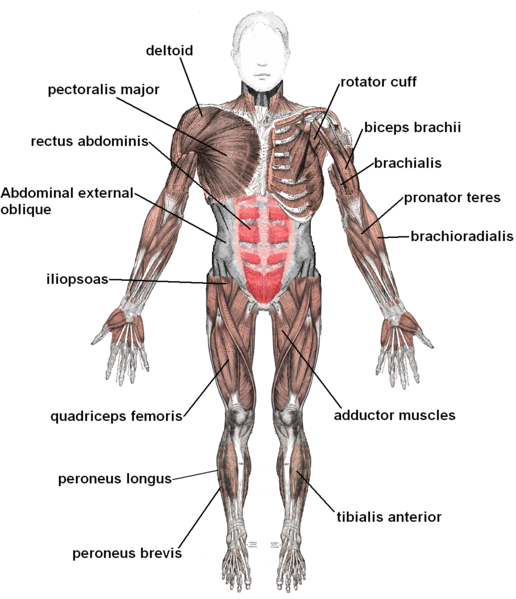Muscle
Muscle (from Latin musculus, diminutive of mus "mouse"[1]) is the contractile tissue of the body and is derived from the mesodermal layer of embryonic germ cells. Muscle cells contain contractile filaments that move past each other and change the size of the cell. They are classified as skeletal, cardiac, or smooth muscles. Their function is to produce force and cause motion. Muscles can cause either locomotion of the organism itself or movement of internal organs. Cardiac and smooth muscle contraction occurs without conscious thought and is necessary for survival. Examples are the contraction of the heart and peristalsis which pushes food through the digestive system. Voluntary contraction of the skeletal muscles is used to move the body and can be finely controlled. Examples are movements of the eye, or gross movements like the quadriceps muscle of the thigh. There are two broad types of voluntary muscle fibers: slow twitch and fast twitch. Slow twitch fibers contract for long periods of time but with little force while fast twitch fibers contract quickly and powerfully but fatigue very rapidly.


Disease
Symptoms of muscle diseases may include weakness, spasticity, myoclonus and myalgia. Diagnostic procedures that may reveal muscular disorders include testing creatine kinase levels in the blood and electromyography (measuring electrical activity in muscles). In some cases, muscle biopsy may be done to identify a myopathy, as well as genetic testing to identify DNA abnormalities associated with specific myopathies and dystrophies.
Neuromuscular diseases are those that affect the muscles and/or their nervous control. In general, problems with nervous control can cause spasticity or paralysis, depending on the location and nature of the problem. A large proportion of neurological disorders leads to problems with movement, ranging from cerebrovascular accident (stroke) and Parkinson's disease to Creutzfeldt-Jakob disease.
A non-invasive elastography technique that measures muscle noise is undergoing experimentation to provide a way of monitoring neuromuscular disease. The sound produced by a muscle comes from the shortening of actomyosin filaments along the axis of the muscle. During contraction, the muscle shortens along its longitudinal axis and expands across the transverse axis, producing vibrations at the surface.
Muscle relaxants
A muscle relaxant is a drug which affects skeletal muscle function and decreases the muscle tone. It may be used to alleviate symptoms such as muscle spasms, pain, and hyperreflexia. The term "muscle relaxant" is used to refer to two major therapeutic groups: neuromuscular blockers and spasmolytics. Neuromuscular blockers act by interfering with transmission at the neuromuscular end plate and have no CNS activity. They are often used during surgical procedures and in intensive care and emergency medicine to cause paralysis. Spasmolytics, also known as "centrally-acting" muscle relaxants, are used to alleviate musculoskeletal pain and spasms and to reduce spasticity in a variety of neurological conditions. While both neuromuscular blockers and spasmolytics are often grouped together as muscle relaxants, the term is commonly used to refer to spasmolytics only.
Spasmolytics like carisoprodol, cyclobenzaprine, metaxalone, and methocarbamol are commonly prescribed for low back pain or neck pain, fibromyalgia, tension headaches and myofascial pain syndrome. However, they are not recommended as first-line agents; in acute low back pain, they are not more effective than paracetamol or non-steroidal anti-inflammatory drugs (NSAIDs), and in fibromyalgia they are not more effective than antidepressants. Nevertheless, there is some (low quality) evidence suggesting that muscle relaxants can add benefit to treatment with NSAIDs.[16] In general, there is no high quality evidence to support their use. No drug has been shown to be better than another, and all of them have adverse effects, particularly dizziness and drowsiness. Concerns about possible abuse and interaction with other drugs, especially if increased sedation is a risk, further limit their use.
Agents like dantrolene and baclofen are not advised for orthopedic conditions, but rather for neurological conditions such as spasticity in cerebral palsy and multiple sclerosis. Dantrolene, although thought of primarily as a peripherally acting agent, is associated with CNS effects, whereas baclofen activity is strictly associated with the CNS.
Muscle relaxants are thought to be useful in painful disorders based on the theory that pain induces spasm and spasm causes pain. However, there is considerable evidence to contradict this theory.









